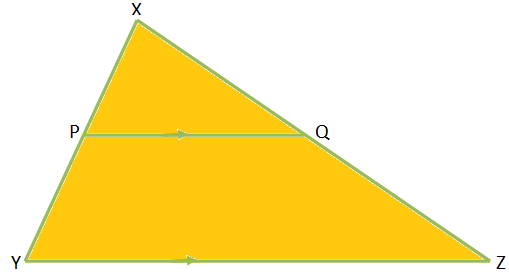Subscribe to our ▶️ YouTube channel 🔴 for the latest videos, updates, and tips.
Converse of Basic Proportionality Theorem
Here we will prove converse of basic proportionality theorem.
The line dividing two sides of a triangle proportionally is parallel to the third side.
Given: In ∆XYZ, P and Q are points on XY and XZ respectively, such that \(\frac{XP}{PY}\) = \(\frac{XQ}{QZ}\).
To prove: PQ ∥ YZ
Proof:
|
Statement |
Reason |
|
1. \(\frac{XP}{PY}\) = \(\frac{XQ}{QZ}\). |
1. Given |
|
2. \(\frac{PY}{XP}\) = \(\frac{QZ}{XQ}\) |
2. Taking reciprocals of both sides in statement 1. |
|
3. \(\frac{PY}{XP}\) + 1 = \(\frac{QZ}{XQ}\) + 1 ⟹ \(\frac{PY + XP}{XP}\) = \(\frac{QZ + XQ}{XQ}\) ⟹ \(\frac{XY}{XP}\) = \(\frac{XZ}{XQ}\) |
3. By adding 1 on both sides of statement 2. |
|
4. In ∆XYZ and ∆XPQ, (i) \(\frac{XY}{XP}\) = \(\frac{XZ}{XQ}\) (ii) ∠YXZ = ∠PXQ |
4. (i) From statement 3. (ii) Common angle |
|
5. Therefore, ∆XYZ ∼ ∆XPQ |
5. By SAS criterion of similarity. |
|
6. Therefore, ∠XYZ = ∠XPQ |
6. Corresponding angles of similar triangles are equal. |
|
7. YZ ∥ PQ |
7. Corresponding angles are equal. |
From Converse of Basic Proportionality Theorem to HOME PAGE
Didn't find what you were looking for? Or want to know more information about Math Only Math. Use this Google Search to find what you need.



New! Comments
Have your say about what you just read! Leave me a comment in the box below. Ask a Question or Answer a Question.